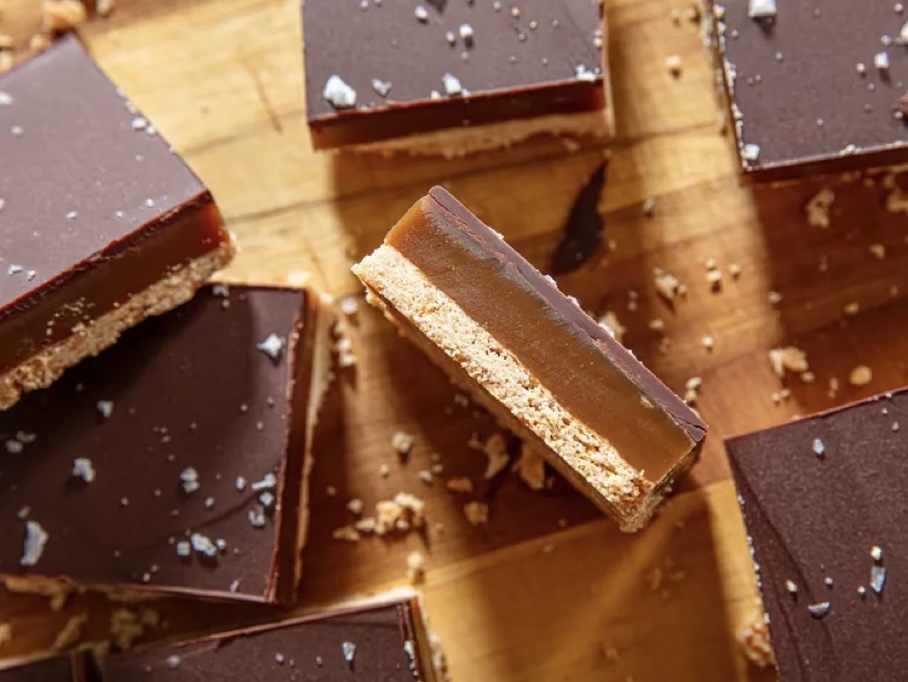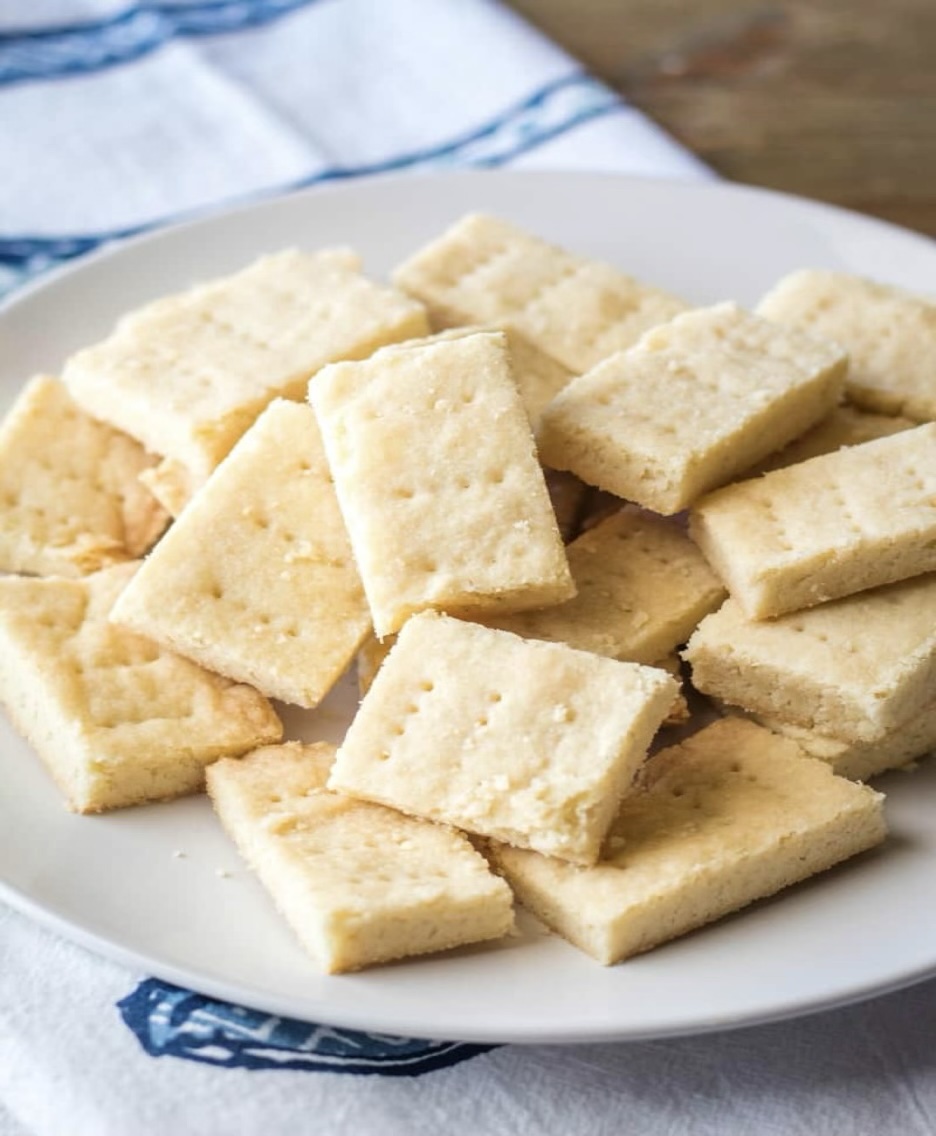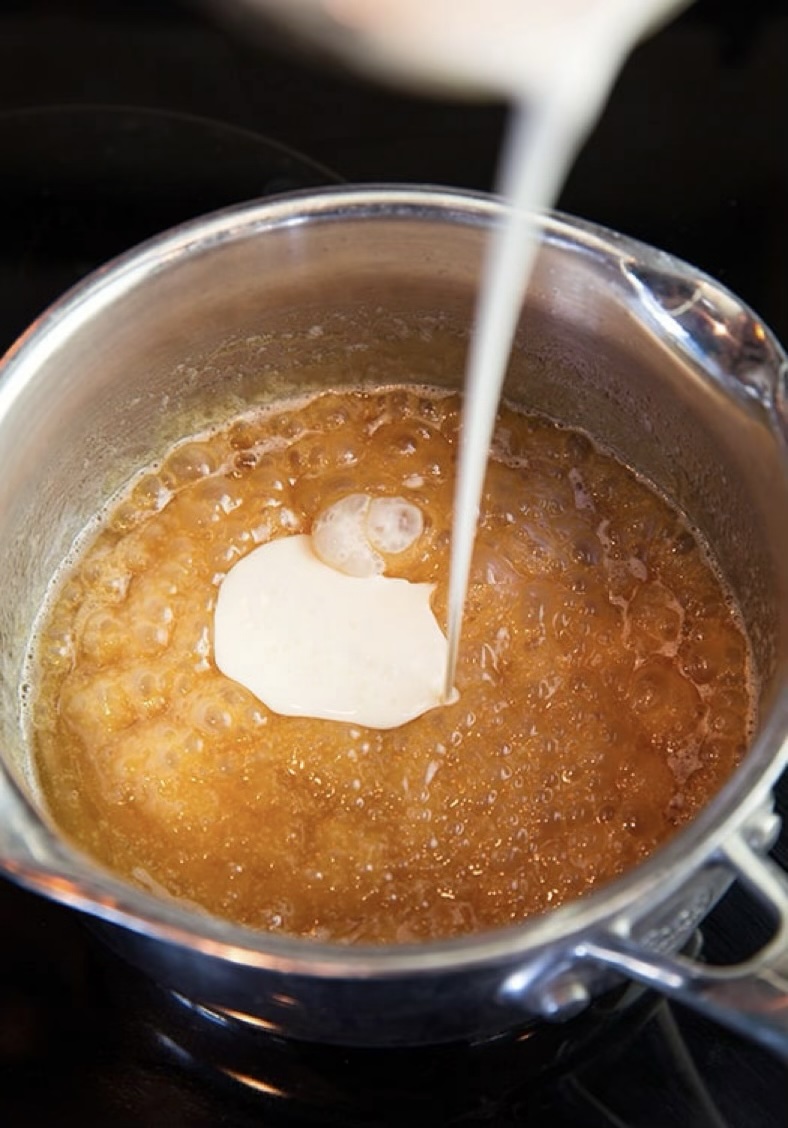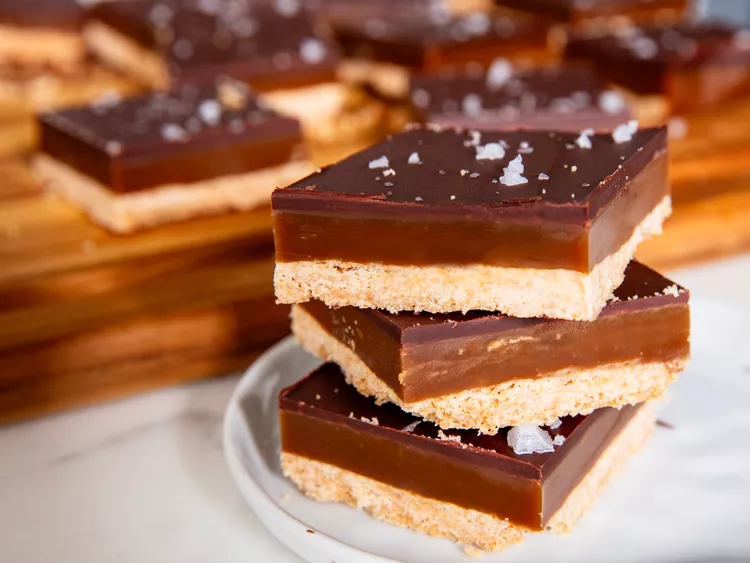It’s Time to Belly-Up to the Bar!
Dessert bar, that is. With cooler weather upon us, it’s time to bake. And what better to bake than ooey gooey bars?
Let’s start with a favorite British bar—the Millionaire Shortbread Bar. Professional bakers agree on this one: “With layers of tender shortbread, rich caramel, and dark chocolate, Millionaire’s Shortbread is a luxurious bar that’s absolutely worth the time it takes!”

Shortbread is different from a sugar cookie in that cornstarch is added to the dough. Incorporating cornstarch softens the proteins in the flour to produce a shortbread with a pleasantly crumbly texture.
This recipe showed up in the early 60’s and was called Caramel Shortbread Fingers. Today it’s morphed into a fatter version—the BAR. Before I share the recipe, let’s look at some tips from food editor and shortbread expert, Genevieve Yam.
She says “Start with good shortbread. You can’t go wrong with shortbread, caramel, and chocolate, but for a truly superb bar, each component should be good enough to enjoy on its own.”

This is an easier version than traditional shortbread recipes, which have you cream softened butter and sugar together. This recipe uses a simple one-bowl method; you pour melted butter over the flour, cornstarch, sugar, and salt. The melted butter evenly coats the dry ingredients, which minimizes gluten development and produces a rich, tender shortbread. There’s also a significant amount of cornstarch, which dilutes the gluten proteins in the all-purpose flour and reduces the overall gluten in the dough.
Genevieve says that you want to be sure to cook the butterscotch to the right temperature. Cook caramel for too long, and you end up with a tough, brittle candy. Cook it too short, and you have a runny sauce. To ensure you have the right texture—soft but satisfyingly chewy—it’s essential to cook the butterscotch to the right stage, and the most accurate way to do that is to take its temperature. You want it to reach 235ºF (113ºC). This is the lower end of what pastry chefs refer to as the soft-ball stage, and she says it’s the “sweet spot.”

For this butterscotch, use unsalted butter, dark brown sugar, heavy cream, and salt. This mixture is what should reach the soft-ball stage. The dark brown sugar brings a deep molasses and toffee note, resulting in a more flavorful butterscotch filling, while the cream and butter add richness.
Chill the bars in stages. Once the butterscotch is poured over the shortbread, it’s essential to chill the bars before adding the chocolate layer. Let them cool first at room temperature, then transfer them to the fridge to further set. A few minutes in the freezer (while whipping up the chocolate topping) is just enough to get them firm enough to slice neatly while also helping the chocolate set a little faster once poured on top.
Top them with DARK chocolate. Don’t substitute. The biggest risk with a dessert like this is that it can come out sickly sweet. A wise chocolate choice is one of the easiest ways to ensure the millionaire's shortbread isn't unbearably sweet.
Genevieve recommends bars with dark chocolate that's around 64 to 72% cacao. Its bittersweet flavor helps offset the intense sweetness of the butterscotch and shortbread.

Finally, remember the salt. There's hardly a dessert that doesn't benefit from the addition of salt, but it's especially important here. It’s about balancing out the inherent sweetness of the components, and a judicious use of salt in each layer goes a long way towards that. A noticeable pop of salt counters the sugar and keeps one foot in beautifully salty-sweet, ever so slightly savory territory.
And now for the recipe. This is Genevieve’s version, as found on www.seriouseats.com. C’mon—it’s time to belly-up to the bar!
Millionaire Shortbread Bar

SHORTBREAD
non-stick cooking spray
1 1/3 cups all-purpose flour
2/3 cup cornstarch
1/4 cup plus 2 teaspoons superfine sugar
1/4 teaspoon kosher salt
11 tablespoons unsalted butter melted
BUTTERSCOTCH FILLING
12 tablespoons unsalted butter
2 cups plus 2 tablespoons dark brown sugar
1 1/2 cups heavy cream
2 teaspoons kosher salt
TOPPING
1 1/4 cups dark chocolate between 64 and 70% cacao, coarsely chopped
1 tablespoon unsalted butter
flaky sea salt to garnish
Directions:
1. For the Shortbread: Adjust oven rack to middle position and preheat oven to 350∫F (175∫C). Line a 9- by 13-inch rimmed baking sheet with an 11- by 17-inch piece of parchment crosswise so the parchment overhangs the rim of the baking sheet by at least 2 inches. (If using pre-cut parchment, you may have to layer two pieces to create the overhang.) Using nonstick cooking spray, grease parchment and baking sheet; set aside.
2. In a large bowl, whisk together all-purpose flour, rice flour or cornstarch, sugar, and salt. Pour melted butter into flour mixture and, using a rubber spatula or dough scraper, incorporate butter into dry ingredients, gently stirring and pressing to combine, until a cohesive dough just forms and no dry bits remain, about 1 minute. (Be careful not to overwork the dough.)
3. Scrape dough into the prepared baking sheet and, using an offset spatula or the flat bottom of a glass or measuring cup, press dough into an even layer. Bake until fragrant and light golden, about 30 minutes. Remove shortbread from oven and set on wire rack to cool to room temperature, about 30 minutes.
4. For the Butterscotch: In a 6-quart pot, melt butter over medium heat. Whisk in brown sugar and salt cook, stirring occasionally, until sugar has melted and begins to bubble, about 5 minutes. Add heavy cream (it will bubble and sputter) and whisk until a loose sauce forms. Bring to a boil over high heat and cook, stirring occasionally, until sauce is thick, shiny, and registers 235∫F (113∫C) on an instant-read thermometer. Remove from heat and allow butterscotch to slightly cool, about 5 minutes. (It should no longer be scorching hot and still be warm enough to pour.)
5. Carefully pour butterscotch over cooled shortbread. Allow butterscotch to sit until warm room temperature, another 30 minutes, then refrigerate uncovered until just set, about 1 hour. Transfer baking sheet to freezer while you prepare the chocolate topping, at least 10 minutes and up to 1 hour.
6. For the Topping: In a medium heat-proof mixing bowl, combine dark chocolate and butter. Set it over a saucepan of simmering water, making sure the bottom of the bowl doesn't touch the water, and heat, stirring occasionally, until chocolate and butter have melted and mixture is homogenous, about 3 minutes. Remove bowl and set on a heatproof work surface. (Alternatively: In a medium microwave-safe bowl, heat dark chocolate and butter on medium-low power, stopping and using a heat-proof flexible spatula to stir every 30 seconds, until completely melted, about 3 minutes.)
7. Remove shortbread from freezer and pour chocolate over shortbread, using an offset spatula to evenly coat butterscotch. Refrigerate until set, about 30 minutes.
8. Lift parchment overhang to gently remove millionaireís shortbread from rimmed baking sheet and transfer to a cutting board. Using a sharp knife, cut bars into squares, rectangles, or desired shape. Serve cold or at room temperature.
2. In a large bowl, whisk together all-purpose flour, rice flour or cornstarch, sugar, and salt. Pour melted butter into flour mixture and, using a rubber spatula or dough scraper, incorporate butter into dry ingredients, gently stirring and pressing to combine, until a cohesive dough just forms and no dry bits remain, about 1 minute. (Be careful not to overwork the dough.)
3. Scrape dough into the prepared baking sheet and, using an offset spatula or the flat bottom of a glass or measuring cup, press dough into an even layer. Bake until fragrant and light golden, about 30 minutes. Remove shortbread from oven and set on wire rack to cool to room temperature, about 30 minutes.
4. For the Butterscotch: In a 6-quart pot, melt butter over medium heat. Whisk in brown sugar and salt cook, stirring occasionally, until sugar has melted and begins to bubble, about 5 minutes. Add heavy cream (it will bubble and sputter) and whisk until a loose sauce forms. Bring to a boil over high heat and cook, stirring occasionally, until sauce is thick, shiny, and registers 235∫F (113∫C) on an instant-read thermometer. Remove from heat and allow butterscotch to slightly cool, about 5 minutes. (It should no longer be scorching hot and still be warm enough to pour.)
5. Carefully pour butterscotch over cooled shortbread. Allow butterscotch to sit until warm room temperature, another 30 minutes, then refrigerate uncovered until just set, about 1 hour. Transfer baking sheet to freezer while you prepare the chocolate topping, at least 10 minutes and up to 1 hour.
6. For the Topping: In a medium heat-proof mixing bowl, combine dark chocolate and butter. Set it over a saucepan of simmering water, making sure the bottom of the bowl doesn't touch the water, and heat, stirring occasionally, until chocolate and butter have melted and mixture is homogenous, about 3 minutes. Remove bowl and set on a heatproof work surface. (Alternatively: In a medium microwave-safe bowl, heat dark chocolate and butter on medium-low power, stopping and using a heat-proof flexible spatula to stir every 30 seconds, until completely melted, about 3 minutes.)
7. Remove shortbread from freezer and pour chocolate over shortbread, using an offset spatula to evenly coat butterscotch. Refrigerate until set, about 30 minutes.
8. Lift parchment overhang to gently remove millionaireís shortbread from rimmed baking sheet and transfer to a cutting board. Using a sharp knife, cut bars into squares, rectangles, or desired shape. Serve cold or at room temperature.
Recipe formatted with the Cook'n Recipe Software from DVO Enterprises.
 Alice Osborne
Alice Osborne
Weekly Newsletter Contributor since 2006
Email the author! alice@dvo.com
